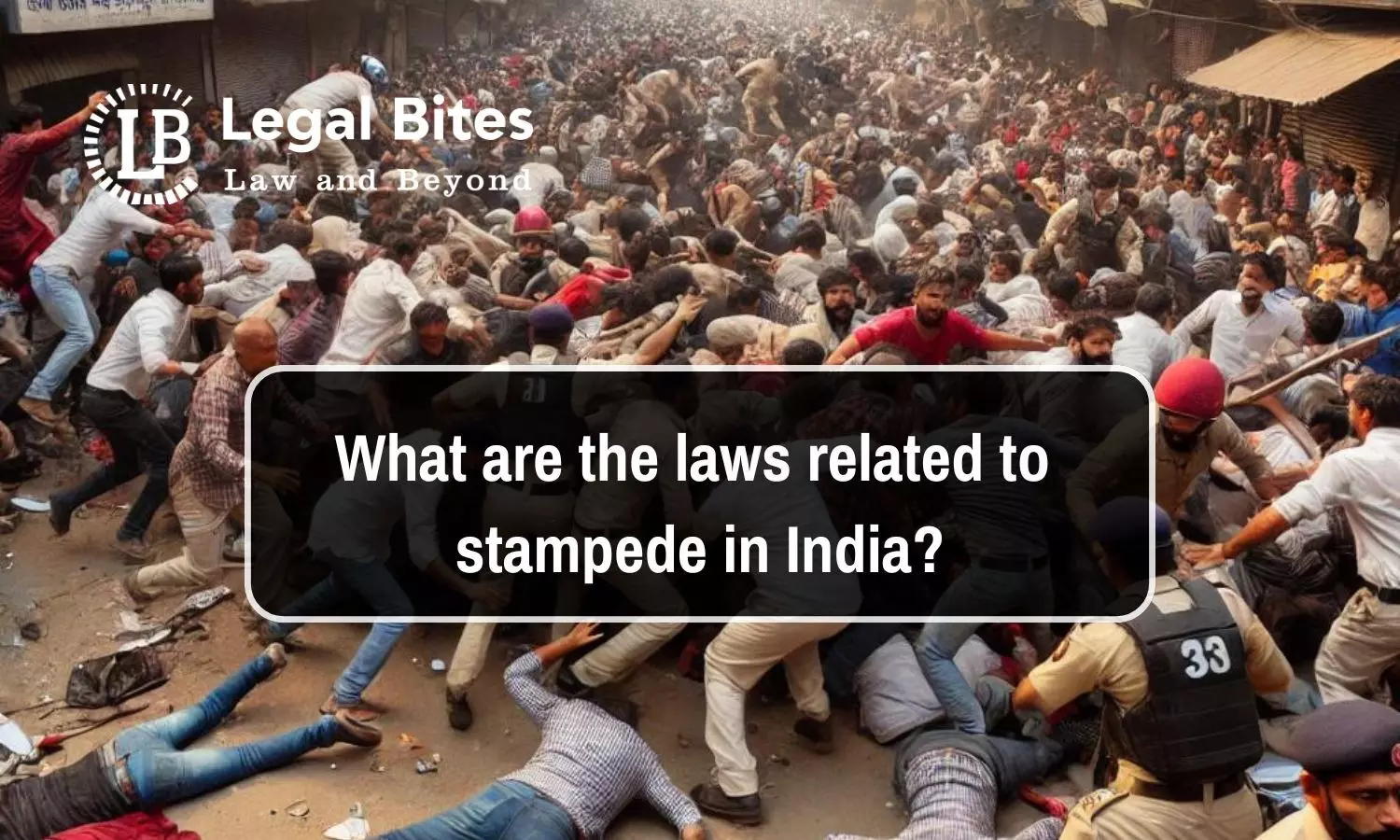What are the laws related to stampede in India? #Hathras Fiasco
Learn about the laws related to stampedes in India, especially in the wake of the tragic Hathras stampede on July 2, 2024.

The tragic stampede in Hathras on July 2, 2024, which resulted in over 100 fatalities, has brought to light the pressing need for effective laws and regulations to prevent such disasters. This article explores the legal framework in India concerning stampedes and crowd management, emphasizing the responsibilities and potential legal repercussions for organizers and authorities.
Bharatiya Nyaya Sanhita (BNS), 2023
The BNS, which replaces the IPC, includes specific provisions relevant to incidents like stampedes.
Section 106: Death by Negligent Act
This section covers deaths caused by rash or negligent acts, increasing the punishment to up to five years of imprisonment. For medical practitioners, the term remains up to two years.
Indian Penal Code (IPC), 1860
Section 304A: Causing Death by Negligence
This section is pivotal in cases where deaths occur due to negligence, such as inadequate crowd management. It prescribes imprisonment of up to two years, or a fine, or both for causing death by a rash or negligent act.
Sections 336, 337, and 338: Acts Endangering Life or Personal Safety
These sections address acts that endanger the life or safety of others. They cover various degrees of harm caused due to negligence:
- Section 336: Acts endangering life or personal safety, punishable by up to three months in prison or a fine.
- Section 337: Causing hurt by an act endangering life or personal safety, punishable by up to six months in prison or a fine.
- Section 338: Causing grievous hurt by an act endangering life or personal safety, punishable by up to two years in prison or a fine.
Disaster Management Act, 2005
This act provides a comprehensive framework for disaster preparedness and response, including guidelines for managing large gatherings. Authorities can be held accountable for failing to implement adequate safety measures.
Public Liability Insurance Act, 1991
This act mandates insurance coverage for potential accidents at public events, ensuring compensation for victims. Organizers must secure adequate insurance to cover liabilities arising from incidents like stampedes.
Local Municipal Laws and Guidelines
Various states and municipalities have specific laws and guidelines for crowd management during public events. These regulations require organizers to obtain permissions and adhere to safety protocols, including provisions for emergency medical aid and proper crowd control measures.
Enforcement and Accountability
Role of Law Enforcement Agencies
Police and local authorities are responsible for overseeing public safety during large gatherings. Non-compliance with their directives can result in legal consequences for organizers.
Court Rulings and Directives
India has experienced several tragic stampedes, leading to significant legal and judicial responses aimed at preventing such incidents and ensuring accountability. Here are some major court rulings and directives related to stampedes in India:
1. Rahul Jain v. Union of India (2014)
In the aftermath of the 2013 Ratangarh Temple stampede in Madhya Pradesh, the Supreme Court of India issued guidelines on crowd management. The court emphasized the need for:
- Adequate planning and preparedness by local authorities.
- Installation of CCTV cameras to monitor crowds.
- Deployment of sufficient police personnel to manage large gatherings.
- Ensuring proper signage and public address systems to guide the crowd.
2. Suo Motu PIL on Kumbh Mela Stampede (2013)
Following the stampede during the Kumbh Mela in Allahabad, the Allahabad High Court took suo motu cognizance and issued several directives:
- Mandatory preparation of a detailed crowd management plan by the state government.
- Ensuring medical facilities and emergency response teams are on standby.
- Setting up temporary hospitals and first aid centres at the event site.
3. Stampede at Sabari Mala Shrine (2011)
After the stampede at the Sabari Mala shrine in Kerala, the Kerala High Court intervened with specific instructions:
- Limiting the number of pilgrims allowed to visit the shrine at any given time.
- Implementing advanced booking systems to manage crowd flow.
- Establishing a centralized command center for real-time monitoring and coordination.
4. High Court of Karnataka on Bangalore's Fireworks Show (2009)
The Karnataka High Court, responding to a stampede during a fireworks show, issued directives to the state government:
- Detailed risk assessment and safety plans for public events.
- Coordination with local fire and emergency services.
- Strict enforcement of safety regulations and penalties for non-compliance.
5. Supreme Court Directive on Safety at Religious Gatherings (2000)
In response to multiple incidents at religious gatherings, the Supreme Court issued broad guidelines:
- Mandatory crowd control measures for events expecting large turnouts.
- Ensuring multiple entry and exit points to prevent bottlenecks.
- Regular safety drills and training for event staff and volunteers.
Key Directives Commonly Emphasized:
- Advanced Planning: Authorities must prepare comprehensive plans for managing large crowds, including risk assessments and emergency response protocols.
- Real-time Monitoring: The use of technology, such as CCTV cameras and public address systems, to monitor and manage crowds effectively.
- Medical Preparedness: Availability of medical facilities and emergency response teams to handle potential casualties.
- Public Awareness: Proper signage, announcements, and information dissemination to guide the crowd and prevent panic.
- Collaboration with Law Enforcement: Coordination with police and emergency services to ensure adequate security and swift response in case of emergencies.
Conclusion
These court rulings and directives underscore the importance of meticulous planning, technological integration, and inter-agency coordination in preventing stampedes and ensuring public safety during large gatherings. The Hathras fiasco is a stark reminder of the importance of stringent crowd management laws and the responsibility of organizers and authorities to ensure public safety. Adherence to the legal framework can significantly mitigate the risks associated with large gatherings and prevent such tragic incidents in the future.
By understanding and implementing these legal provisions, we can honour the memory of those who lost their lives in Hathras and work towards safer public events in India.
For more legal insights and updates, visit Legal Bites
Next Story

